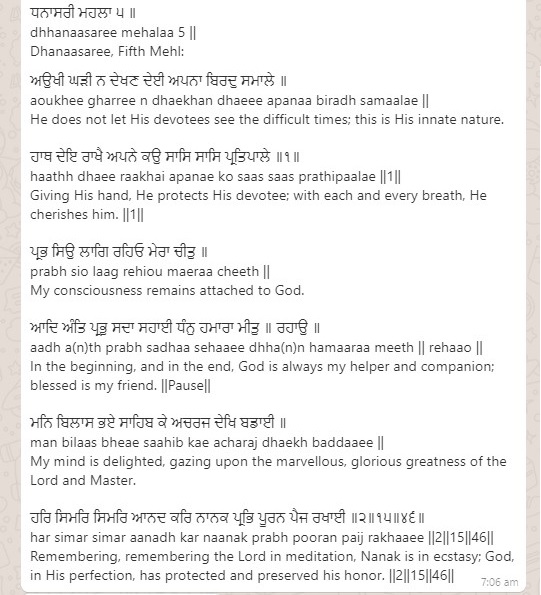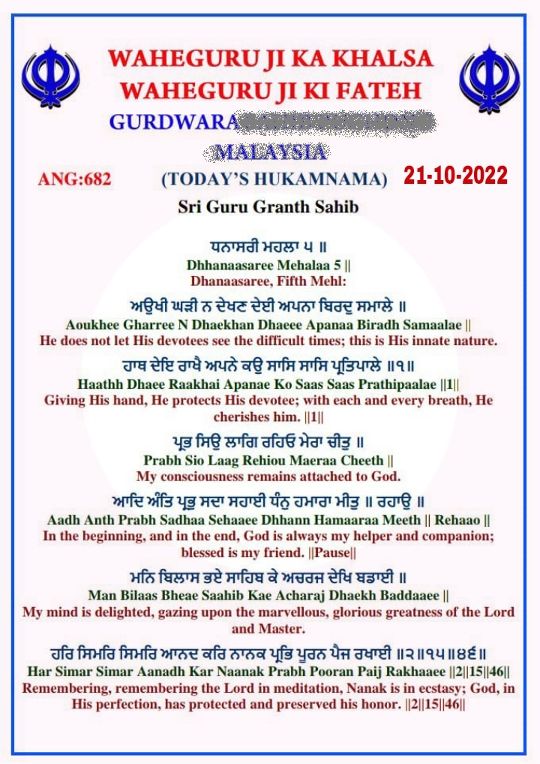
I was sitting in my porch contemplating on what topic to write for my next blog and video post when suddenly I received a WhatsApp message. Someone had actually put my number in their WhatsApp group (without my consent of course). But I believe they did it with good intention, perhaps thinking, “isda bhi bhalla ho jaiga.” – (he will also benefit).
I won’t mention names but it’s been a few days now since I’ve been in this WhatsApp group and I’ve been observing closely the messages that are circulating in there.
Two (2) such messages caught my eye.
It was a Hukamnama from a few days ago (from two local Gurdwaras). I heard the audio recording of the first Hukam and I also read the translations of both the hukams (screenshots taken by both Gianis who shared it in that group).
WHAT SURPRISED ME MOST WAS BOTH HUKAMNAMAS FROM TWO DIFFERENT GURDWARAS WERE IDENTICAL!
Exactly the same! Could it be a coincidence? Could it be pre-planned? Hold on! What’s happening here?!
There could be 3-possibilities why this happened.
- Both Gianis planned to take the same Hukam since the WhatsApp group was created on the same day too;
- The Gianis are accustomed to only reading Hukamnamas which they are well versed with and so happened the same Hukam was taken because its easier to explain the meanings;
- It could be a real coincidence that both Hukamnamas happen to be identical on the same day.
You can say I’m exaggerating but I’d be totally amazed if the latter was true because if you actually learnt how to take the Hukamnama from Sri Guru Granth Sahib Ji (SGGS) correctly, chances are no 2-persons could take the same Hukamnamas . Chances are extremely slim but of course, not entirely impossible either.
Anyway, the Hukam taken is a common shabad within SGGS which I’m sure you have either heard or read it yourself. Here is what I observed:
- Giani No-1 who recorded himself taking the Hukamnama and interpreted it, read it well with a few mistakes in pronunciation, wrong pauses here and there but more so his explanation of the Hukamnama itself was off.
- The English translation of both the Hukamnamas they screenshot and shared in the group were also deeply flawed.
Here’s the screenshot of the English translation of the Hukamnama shared by Giani No-1:

Here’s the screenshot of the same Hukamnama taken by Giani No-2:

If you observe carefully, you will notice both English translations are exactly the same but surprisingly they are taken from TWO different Gurbani apps.
Flawed Translations
Before I go further, let’s first understand why I said the English translations of this shabad which was shared by 2 Gianis via 2 different phone apps are deeply flawed.
- In the Rahao stanza, the translation is not descriptive enough and it is done in 1st person. “My consciousness remains attached to God.” This is incorrect. This shabad which is composed by Guru Arjan Dev Ji is composed in 3rd person narrative, not 1st person. The message is for mankind, for our minds.
- The next line of the Rahao stanza, the translation reads, “In the beginning, and in the end, God is always my helper and companion;” In the beginning and in the end only? What happened to life in between?
- Then it says, “blessed is my friend. ||Pause||” Who is blessed here? God is blessed? Or is it we are blessed to have God as our companion? What is the meaning of ‘companion’? Is God being referred to as some kind of entity, sitting in the skies? Very unclear.
- In the 1st stanza, it says ” He does not let His devotees see the difficult times; this is His innate nature.” But so many people are suffering. So many ‘devotees’ who give alms, visit sacred shrines regularly, do langar sewa are suffering. Who are His devotees? Are Sikhs considered devotees? If a Sikh donates towards charity, is he/she considered a devotee? When one gives the Giani shabad-peth (money in the bowl) when the Giani is doing Kirtan, is he a devotee?
- The line, ਹਾਥ ਦੇਇ ਰਾਖੈ ਅਪਨੇ ਕਉ has been literally translated as “Giving His hand, He protects His devotee; Where is God’s hand? How does it look like? Then in the next part, its even more fuzzy as the translation reads, “with each and every breath, He cherishes him.” Who cherishes who? God cherishes his devotees or do the devotees cherish God? Does God cherish himself? What is this concept of cherishing God? Totally confusing!
- The last part of stanza no-2, says ” My mind is delighted, gazing upon the marvellous, glorious greatness of the Lord and Master.” Question is how can the mind gaze? Its always eyes that gaze. So again, literal meaning and wrongly translated.
- Last line of stanza 2, read “Remembering, remembering the Lord in meditation, Nanak is in ecstasy; God, in His perfection, has protected and preserved his honor.” So, the translator is saying that we should remember God by doing meditation? Is that how God wishes to be remembered? So, are we to meditate like a Yogi? But Guru Nanak himself was against such Yogic meditation practices. Chanting and meditating again comes from Snatan theology. It is NOT Gurmat philosophy.
- The final bit says, “Nanak is in ecstasy; God, in His perfection, has protected and preserved his honor.” Guru Nanak, in this case Guru Arjan is in ecstasy? Can’t a Sikh of the Guru feel ecstasy too? Isn’t Gurbani meant to elevate and provide a state of bliss and ecstasy for its followers?
Correct Translations
Here is the translation of the same shabad, based on my understanding:
NOTE: Whenever we want to understand Gurbani shabad, whether it’s from Amrit Kirtan, Gutkas, phone apps etc, we need to first take a close look at the Rahao stanza. The Rahao is like a compass, a gist of the idea or concept the composer of the shabad wants to share with us. The Rahao basically sets the tone of the message contained within the whole shabad.
This shabad is composed by Guru Arjan Dev Ji (5th Guru) in Raag Dhanasree.
ਪ੍ਰਭ ਸਿਉ ਲਾਗਿ ਰਹਿਓ ਮੇਰਾ ਚੀਤੁ ॥
Prabh Sio Laag Rehiou Maeraa Cheeth ||
ਆਦਿ ਅੰਤਿ ਪ੍ਰਭੁ ਸਦਾ ਸਹਾਈ ਧੰਨੁ ਹਮਾਰਾ ਮੀਤੁ ॥ ਰਹਾਉ ॥
Aadh Anth Prabh Sadhaa Sehaaee Dhhann Hamaaraa Meeth || Rahao ||
Meaning:
May the mind’s consciousness, focus, be attached to the divine virtues of God (prabh sio). From the beginning (aadh), from the time when we are born, throughout our lifetime and until we die (anth), may God’s true wisdom (Sacha Gyan) be with us as I have taken this understanding to be my greatest friend (meeth).
- Aadh, Anth as what is commonly described by most clergy as ‘during ones birth (in the womb of the mother) and at the time of death (or after-life)’. How about the center, during the entire lifetime of the being? That is why Guru Sahib used the word ਸਦਾ (at all times) but the translation doesn’t explain this.
- Gurbani’s messages are for the human being to understand and apply the teachings and instructions from the Guru in the here and now. While we are still alive. It has NOTHING to do with before or after death. Gurmat does not conform to such tales. The clergy’s explanation on this was incorrect.
ਅਉਖੀ ਘੜੀ ਨ ਦੇਖਣ ਦੇਈ ਅਪਨਾ ਬਿਰਦੁ ਸਮਾਲੇ ॥
Aoukhee Gharree Na Dhaekhan Dhaeee, Apanaa Birdh Samaalae ||
Meaning:
When one’s mind and focus is attached to God’s divine virtues (sacha gyan) difficulty and hardship even though it happens, the disciple does not let it affect him/her.
Note:
It is common to hear many pronounce the word ਦੇਈ with a bindi (sound from the nassal). This is incorrect. Firstly, there is no bindi in the the word ਦੇਈ. The pronunciation is supposed to be without the bindi nasal sound. Sound without the bindi means, “did not give”. But if one were to apply the bindi, the meaning will change to a request rather than a statement. As if Guru Sahib is requesting, “please do not let me to experience hardship”. The wrong pronunciation can cause the entire meaning to change.
ਹਾਥ ਦੇਇ ਰਾਖੈ ਅਪਨੇ ਕਉ ਸਾਸਿ ਸਾਸਿ ਪ੍ਰਤਿਪਾਲੇ ॥੧॥
Haathh Dhaee Raakhai Apanae Ko Saas Saas Prathipaalae ||1||
Meaning:
God’s divine knowledge and truth protects the ones who live their lifes according to His Will, who know about the Law of the Universe (Hukam), are always protected, as they will know what to do when the situation befalls them.
ਮਨਿ ਬਿਲਾਸ ਭਏ ਸਾਹਿਬ ਕੇ ਅਚਰਜ ਦੇਖਿ ਬਡਾਈ ॥
Man Bilaas, Bheae Saahib Kae, Acharaj Dhaekh Baddaaee ||
Meaning:
My mind has become joyous upon living my life according to His will, understanding His laws of nature. This is the greatness of God that I’ve come to realize.
ਹਰਿ ਸਿਮਰਿ ਸਿਮਰਿ ਆਨਦ ਕਰਿ ਨਾਨਕ ਪ੍ਰਭਿ ਪੂਰਨ ਪੈਜ ਰਖਾਈ ॥੨॥੧੫॥੪੬॥
Har Simar Simar Aanadh Kar Naanak Prabh Pooran Paij Rakhaaee ||2||15||46||
Meaning:
Realizing God’s Divine Virtues (His nature, His laws) one shall experience true bliss, Nanak says; the complete and perfect God (Hukam) will care and protect the ones who keeps this knowledge always in their minds.
Compare the English translations in both the above screenshots shared by the Gianis and you will notice the difference.
Likely Reasons
To be honest, most Gianis we see today in Malaysia or in neighboring countries, have very little to non-existent grasp of the English language. Many cannot speak, read or write in English. So, chances are, most will simply take the screenshots of the translations in phone apps and share it in WhatsApp groups.
Secondly, most Sikh masses today, due to their busy lifestyles, prefer to simply read the English translations from Gurbani apps without putting much thought or effort of benchmarking the translations with authentic Sikhi principles.
If one were to dig deeper to understand why we have become so reliant on English translations, 3-reasons come to my mind:
- Reason #1: SGGS Saroop Pooja
We have steadily distanced ourselves from reading Gurbani for ourselves and more importantly trying to put some effort in understanding Gurbani. This is probably because of what the Clergy have been telling us to do. Sadly we have been taught to worship the physical (saroop) of the Sri Guru Granth Sahib and not read and understand the shabads contained within it. - Reason #2: Language Barrier
Most of the younger generation Punjabis can’t read, write or even speak Punjabi. They’re not trained in Gurmukhi (the script used in SGGS). Moreover, our Gurus and Bhagats have used various languages such as Braj Bhasha, Kauravi, PraKrit, Sanskrit, Sindhi, Persian, etc in SGGS as these were predominant languages spoken back then. - Reason #3: Gurbani Structure
Gurbani within SGGS is written in complex divine poetry with deep spiritual messages and concepts which have been re-defined by Guru Nanak and all the Gurus and Bhagats. I call these Gurmat based concepts. Unless one has spent some time to learn these Gurmat concepts and discard the Snatan, Brahmanwaad concepts, it is practically impossible to know what the ‘real’ message of Gurbani is.
The English translations of Gurbani contained within most, if not all, phone applications (iphone and androis apps) are literal meanings and are based on the famous Fareedkoti Teeka (funded by the state government and done by the Benares Nirmala priests back in 1883). Their translations have a deep Vedic, Puranic and Brahmmanical context and slants which are NOT in line with Guru Nanak’s authentic Sikh philosophy.
Who Is Responsible?
Actually, if we look back from very early on, THREE groups of deviant and anti-Sikhi (namely the Udassis, Nirmalas and Sant Deras) have been involved in this elaborate scheme of distorting Gurbani and shattering Guru Nanak’s divine universal philosophy called Sikhi.
These groups are directly responsible for the control of Sikh literature, Gurdwaras, Sikh centers, even to the exent of infiltrating and taking over Darbar Sahib, Amritsar (and later renaming it as Harimandir). Even Akaal Takhat and SGPC were not spared.
Question is why was the very FIRST Punjabi translation of SGGS carried out by a group of Benares Hindu Nirmala priests? (It’s a long story. Perhaps best kept for a blog post or video for another day.)
If you do a Google search to find out who was the first to translate SGGS in English, you will discover a Dr. Gopal Singh’s name appear. Apparently he did the translation back in 1960 but there is not much of information or evidence of this.
What you will find most often is a Sant Singh Khalsa MD’s name appear.
I have personally examined many phone apps and discovered most, if not all, the apps are using Sant Singh Khalsa MD’s English translations of Gurbani and there is something terribly wrong with the English translations done by him.
His translations are based on the distorted, Brahmin influenced, Fareedkoti Teeka.
What worries me more is that Sant Singh Khalsa MD’s work is most prevalent and used across various channels, phone applications, social media, websites, desktop softwares, etc. Even the Powerpoint slides we use in Gurdwaras and projected on the screens are using Sant Singh Khalsa MDs English translations.
Possible Solutions
So, this begs the question. What should we do? Should we stop reading the English translations from phone apps?
Yes! Maybe.
But if we were to do that, we will need to make an effort to understand the CORRECT Sikhi concepts or Gurmat based concepts of SGGS. We need to align ourselves with the correct philosophy of Guru Nanak’s teachings first so that we do not need to rely on the distorted Gurbani-English translations in phone apps.
One such scholar, Dr Karminder has done a great job in sharing about the 12-common Sikhi concepts.
What would you rather do?
Understand the wrong concept or the correct one? Of course, you would choose to understand something correctly, especially something so important as the basis of our spirituality.
There is a definite need to educate ourselves and un-learn the wrong and re-learn Guru Nanak’s authentic Sikhi concepts.
More importantly, we need to refrain from blindly sharing hukamnamas in WhatsApp groups! Otherwise, there is little hope that we will ever rid ourselves from pre-1469 Brahmin beliefs and ever walk on the true path of Guru Nanak’s spirituality.
Sikh Philosophy Is Unique
You MUST know that Sikhism is not a branch of Hinduism and neither is it an offshoot of Islam. Otherwise, it would have been pointless for Guru Nanak to have spent his whole life, pursuing and documenting Gurbani and passing the torch of spirituality to Guru Angad, Guru Amar Das, Guru Ram Das and so on.
It took the Gurus 239 years to complete Guru Nanak’s mission. All for what? Because Sikhs are a branch of Hinduism? Or because Sikh faith shares similarities with Islam? Think about it.
Bhai Gurdas Ji has beautifully answered. He says:
ਮਾਰਿਆ ਸਿਕਾ ਜਗਤ੍ਰਿ ਵਿਚਿ ਨਾਨਕ ਨਿਰਮਲ ਪੰਥ ਚਲਾਇਆ।
Maariaa Sikaa Jagati Vichi Naanak Niramal Pandu Chalaaiaa.
Meaning:
Guru Nanak has created a UNIQUE Spirituality In This World.
Sikhi of Guru Nanak is definitely unique and different from the rest. We just need to put some effort in knowing the differences and applying the unique concepts of Sikh spirituality into our life.
It all starts from understanding the correct meanings of the shabads contained within Guru Granth Sahib and not rely upon the deeply flawed English translations found in phone apps.



